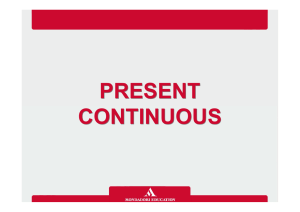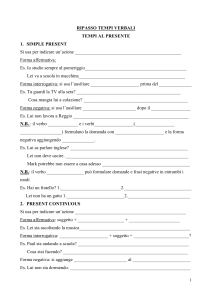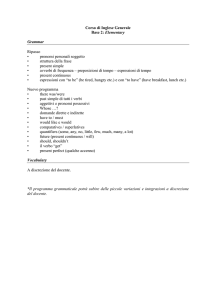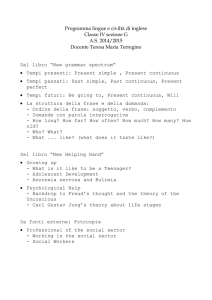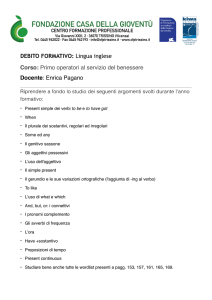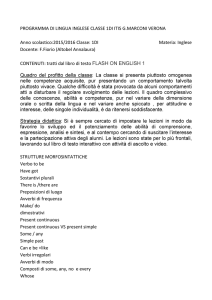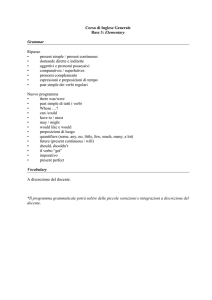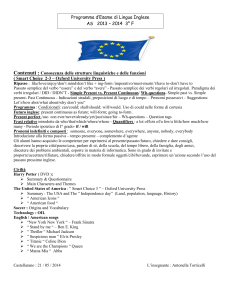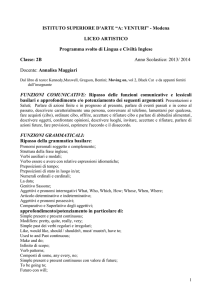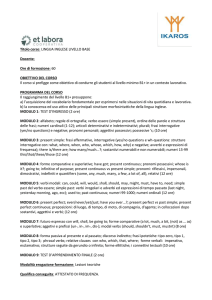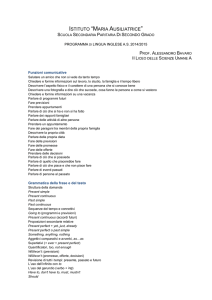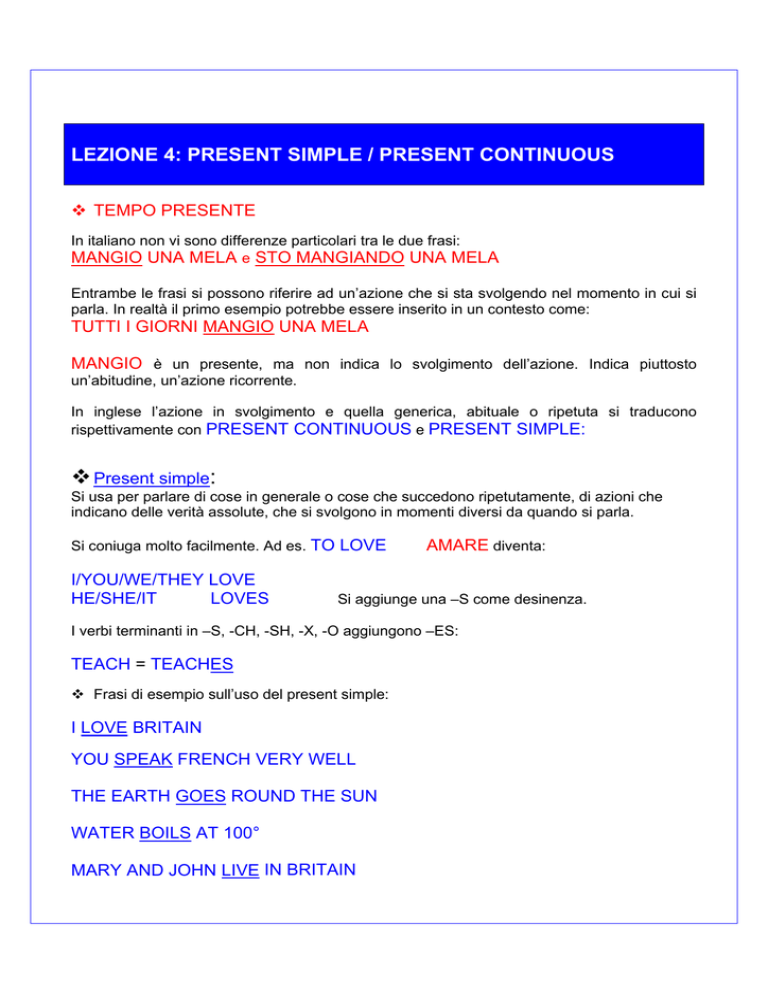
LEZIONE 4: PRESENT SIMPLE / PRESENT CONTINUOUS
TEMPO PRESENTE
In italiano non vi sono differenze particolari tra le due frasi:
MANGIO UNA MELA e STO MANGIANDO UNA MELA
Entrambe le frasi si possono riferire ad un’azione che si sta svolgendo nel momento in cui si
parla. In realtà il primo esempio potrebbe essere inserito in un contesto come:
TUTTI I GIORNI MANGIO UNA MELA
MANGIO è un presente, ma non indica lo svolgimento dell’azione. Indica piuttosto
un’abitudine, un’azione ricorrente.
In inglese l’azione in svolgimento e quella generica, abituale o ripetuta si traducono
rispettivamente con PRESENT CONTINUOUS e PRESENT SIMPLE:
Present simple:
Si usa per parlare di cose in generale o cose che succedono ripetutamente, di azioni che
indicano delle verità assolute, che si svolgono in momenti diversi da quando si parla.
Si coniuga molto facilmente. Ad es. TO LOVE
I/YOU/WE/THEY LOVE
HE/SHE/IT
LOVES
AMARE diventa:
Si aggiunge una –S come desinenza.
I verbi terminanti in –S, -CH, -SH, -X, -O aggiungono –ES:
TEACH = TEACHES
Frasi di esempio sull’uso del present simple:
I LOVE BRITAIN
YOU SPEAK FRENCH VERY WELL
THE EARTH GOES ROUND THE SUN
WATER BOILS AT 100°
MARY AND JOHN LIVE IN BRITAIN
Per formare la frase negativa abbiamo bisogno dell’ausiliare DO + la particella NOT
THEY DON’T EAT RAW FISH
I DON’T GO TO SCHOOL ON SUNDAYS
Allo stesso modo, per formare la forma interrogativa necessitiamo dell’ausiliare DO
DO YOU GO TO SCHOOL ON SUNDAYS?
DO THEY EAT CHOCOLATE?
Present continuous
Si usa per parlare di cose che succedono al momento. L’azione non è finita, è in corso, in
svolgimento.
Si coniuga con l’aiuto dell’ausiliare TO BE seguito dalla forma in –ing del verbo principale.
SOGGETTO (I/YOU/HE/SHE/IT/WE/THEY)
+
VERBO ESSERE CONIUGATO (AM/ARE/IS)
+
FORMA IN –ING
Dunque se devo dire IO STO BEVENDO UN SUCCO D’ARANCIA dirò:
I + AM + DRINKING + naturalmente il complemento che in questo caso sarà
AN ORANGE JUICE.
Per fare le forme interrogativa e negativa seguiamo la regola del verbo ESSERE = TO BE:
I AM NOT READING
ARE YOU STUDYING?
Qualche esempio:
I AM READING A BOOK
PLEASE BE SILENT, I’M SPEAKING ON THE PHONE
PAUL IS NOT GOING HOME. HE IS STILL HERE.
WHERE IS JANE? SHE IS STUDYING GERMAN IN HER BEDROOM.
IS ANN GETTING BETTER AFTER HER TERRIBLE COLD?
Attenzione! Alcuni verbi non si usano solitamente al present continuous:
like, love, want, know, understand, depend, prefer, remember, hate, mean,
believe, forget. Vogliono la forma al PRESENT SIMPLE.
Si dice:
I’M VERY HUNGRY. I WANT TO EAT SOMETHING.
HO MOLTA FAME. VOGLIO MANGIARE QUALCOSA.
I DON’T UNDERSTAND WHAT YOU MEAN.
NON CAPISCO CIO’ CHE INTENDI.
ATTENZIONE: se stiamo parlando di un’azione che si sta svolgendo in un’arco di tempo
comprendente anche l’attuale, ma non necessariamente continuata usiamo il PRESENT
CONTINUOUS:
A- HELLO PETER, HOW ARE YOU?
B- FINE AND YOU?
A- NOT SO BAD. I’M WORKING IN A PUB AT THE MOMENT, AND YOU?
B- I’M AN ACCOUNTANT. I WORK IN A BANK.
…
ESERCIZIO 4
Traduci in inglese le seguenti frasi:
1. Lavori in banca? Sì, ma alla sera vado a scuola. Sono anche studente.
2. Ti piace la carne? Sì, ma preferisco il pesce.
3. Non studio inglese perché non mi piace.
4. La Terra gira intorno al sole e la luna gira intorno alla Terra.
5. Roberto non crede alla magia.
6. Le banche inglesi aprono alle 8 e chiudono alle 5.00.
7. Le donne italiane comprano vestiti costosi.
8. Gli uomini inglesi bevono molta birra e mangiano patatine fritte.
9. Parli spagnolo? No, ma parlo francese e tedesco.
10.
Non voglio mangiare. Non ho fame e sono molto stanco.
11.
Che cosa stai facendo? Sto mangiando un panino.
12.
Dove vanno? Vanno a scuola perché frequentano un corso pomeridiano.
13.
Ascolta!* Qualcuno sta aprendo la porta.
14.
Studia sempre, ma adesso non sta facendo i compiti.
15.
Lasciami in pace.** Sto cercando di dormire.
* Ascolta (modo imperativo) si traduce con LISTEN
** Lasciami in pace (modo imperativo) si traduce con LEAVE ME ALONE
ESERCIZIO 5
Leggi e traduci
Daily routine
During the week I usually wake up at 6.30 a.m. I sometimes lie in bed for five minutes but
then I have to get up. Most evenings, I go to bed at about 11.30 p.m. I’ m usually very tired,
so I go to sleep very quickly. When that happens, I sometimes manage to fall asleep about 3
a.m., then I oversleep in the morning. If I have a late night, I try to have a nap in the
afternoon. The weekends are different. On Saturday and Sunday I have a lie-in.
In the week I have breakfast at 7.30 a.m., lunch at 1.00 p.m., and dinner around 7 p.m. I also
have one snack during the day at work. As I live alone, I also have to make my own breakfast
and dinner, but during the week I don’t cook very much. I also have to feed my two cats twice
a day as well.
In the summer I have a shower in the morning, but in the winter I often have a bath instead.
Sometimes I have a shave at the same time, or I shave when I have a wash and clean my
teeth after breakfast. I wash my hair two times a week.
In the morning I leave home about 8.15 a.m. and get to work by 9 a.m. I have a lunch break
from 1 to 2 p.m., and I leave work around 5.30 p.m.
During the week I usually stay in and have a rest. But at the weekend I often go out or I have
friends for dinner. We have a chat or we play cards.
I do the shopping on Saturday. Fortunately I have a cleaner, so she does my washing , the
washing up and does most of the ironing.
ESERCIZIO 6
Scrivi la tua “daily routine” ispirandoti al brano appena letto:
Vediamo il nome di alcuni mestieri e professioni:
FARMER
TEACHER
LAWYER
SALES REPRESENTATIVE
CLERK
SECRETARY
ARCHITECT
ENGINEER
PILOT
HAIRDRESSER
CHEMIST
CONTADINO
INSEGNANTE
AVVOCATO
RAPPRESENTANTE
IMPIEGATO
SEGRETARIA
ARCHITETTO
INGEGNERE
PILOTA
PARRUCCHIERE
FARMACISTA
Ricorda ancora una volta che per chiedere a qualcuno che lavoro fa, si dice WHAT DO
YOU DO? E si risponde con I AM A DOCTOR.

